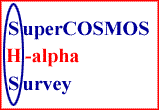
|
| SuperCOSMOS |
| H-alpha Survey (SHS) |

|
|
Catalogue Parameters
Global astrometry is tied to the Tycho-ACT reference catalogue, and the
mean errors in RA or DEC will be around 0.2" for bright stars. Very faint
objects will have increased random noise and additional systematic error
at a similar level (a few tenths of an arcsecond).
Proper motions in units of mas/yr are provided for every image paired
between the UKJ and UKR (SES-R) plates. We followed the prescription
given by Evans & Irwin, MNRAS, 277, 820 (1995) in the derivation of the
pms using the UK Schmidt J plates as primary (first epoch) and the
UK Schmidt R plates as
secondary data. The mean proper motions of all galaxies are set to
zero in this procedure, so they are on an extragalactic reference frame.
Differential colour refraction corrections have been applied to minimise
systematic errors in the pms of stars having extreme colour.
Note that when an image is not paired between the J and second epoch R
plates, no proper motion is available and the null value of 9.99E8 is
returned (this can happen if a particular object is not detected for
some reason on the J or R plate). This also applies to fields where no
second epoch R data are currently available.
The pairing limit between any two plates is 3 arcsec; consequently for
a median epoch difference between UKJ and UKR of 15 years, the upper
proper motion limit is 0.2 arcsec/yr. In fields where the epoch
difference is smaller, the upper proper motion limit will be higher of
course.
Each proper motion value is accompanied by an error estimate since the
plate qulaity can vary from field to field, and also because different
epoch differences yield different proper motion errors. Moreover,
galaxy centroiding is in general about a factor 2 less accurate than
stellar image centroiding, so error estimates depend on image type;
the errors are also a function of magnitude. In the case of stellar
proper motion errors, these will be slightly overestimated from the data
itself since error distributions are affected by real stellar motions.
Note that brighter than 18th magnitude, there will be systematic errors
in the stellar proper motions (increasing with magnitude) at the level
of 10 mas/yr (for a median epoch difference of 15yr).
Roughly calibrated magnitudes are provided in this parameter. These are
currently tied to bright photometry from the Tycho and Guide Star
Photometric Catalogues. Field-to-field zeropoints have been removed,
and the calibrations are tied to faint CCD standards from Croom et al.
(1999, MNRAS, 306, 592), Boyle et al. (1995, MNRAS, 276, 33), Stobie et
al. (1985, A & AS, 60, 503), Cunow et al. (1997, A & AS, 125, 71 and
references therein), Maddox et al. (1990, MNRAS, 246, 433) and Collins
(private communication). Bright
stars will have systematic errors as a function of position on the
plate. Systematic errors of a few tenths of a magnitude will be likely;
errors of 0.5 mag or more are less common but nonetheless present.
Note that stellar magnitudes are based on calibrated profile magnitudes,
while galaxian magnitudes are calibrated isophotal magnitudes, sky divided
and corrected to total magnitudes.
In October 2000 the R/I photometric calibration was changed to account
for systematic errors
in colour as a function of position and magnitude. The corrections
have been done with respect to the J magnitudes, which have not
changed (ie. J-R and J-I colours are now self-consistent and anchored
at the same median value across the entire survey).
The full 32 IAM parameter sets for each plate have two instrumental
magnitudes called COSMAG and PRFMAG. The COSMAG parameter is an
isophotal magnitude (-2.5log{sum of intensities of thresholded pixels
above sky}) while the PRFMAG parameter is a `linearised' profile
magnitude computed following the prescription of Bunclark & Irwin (1983,
Proc. Statistical methods in Astronomy Symp., ESA SP-201, 195)
Image classification (based on morphological parameters and areal profile
shape) provides a classification flag: 1=galaxy, 2=star,
3=unclassifiable, 4=noise. In listings showing the full object
parameters the profile classification stage also writes
a classification statistic which is 1000x the number of
sigmas an image profile set is away from the mean stellar areal profile
set at that particular brightness and position on the plate. A "linearised"
profile magnitude is also written and is used for
stellar magnitude calibration.
The quality flag gives and indication of how "good" an
image is in the sense that the higher the value, the more likely an
image is to be spurious. Bits are set in this flag by the image analysis
software such that more severe conditions are flagged using more
significant bits. The nominal threshold for a severe defect is 65535 -
images having a quality value less than this value but greater than zero
are not necessarily spurious. non-zero values should be regarded as
a warning of possible problems with the image.
Home |
Intro |
Get an Image |
Get a
Catalogue
Coverage |
Documentation |
History |
Links
WFAU, Institute for Astronomy,
Royal Observatory, Blackford Hill
Edinburgh, EH9 3HJ, UK
Tel +44 131 668 8356 (office)
or +44 131 668 8100 (switchboard)
M.Read@roe.ac.uk
21-Jan-2002
 |

